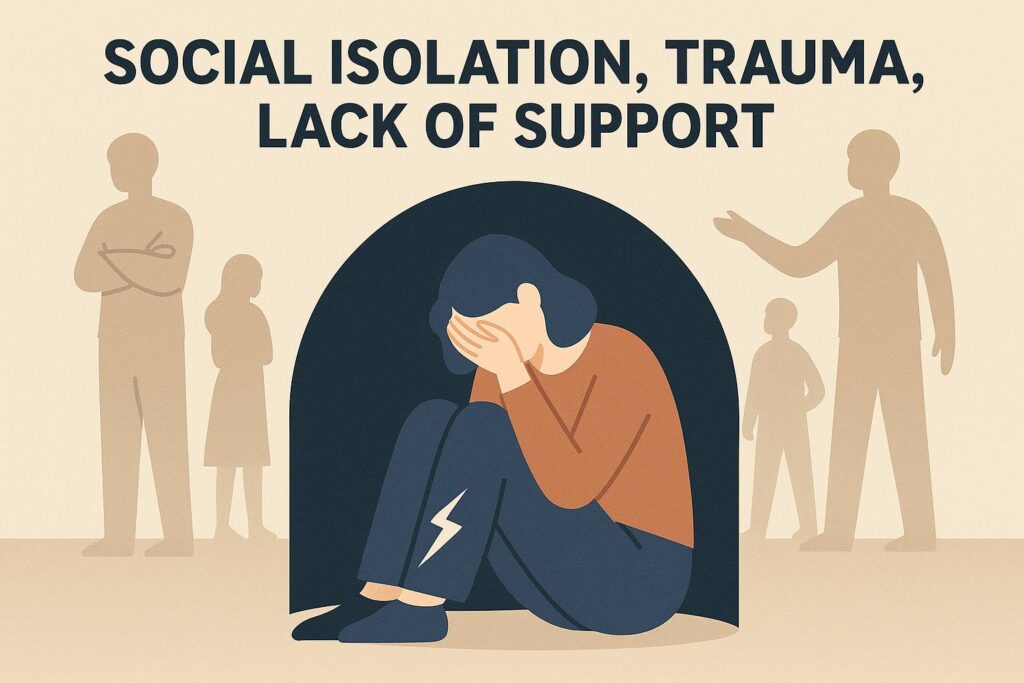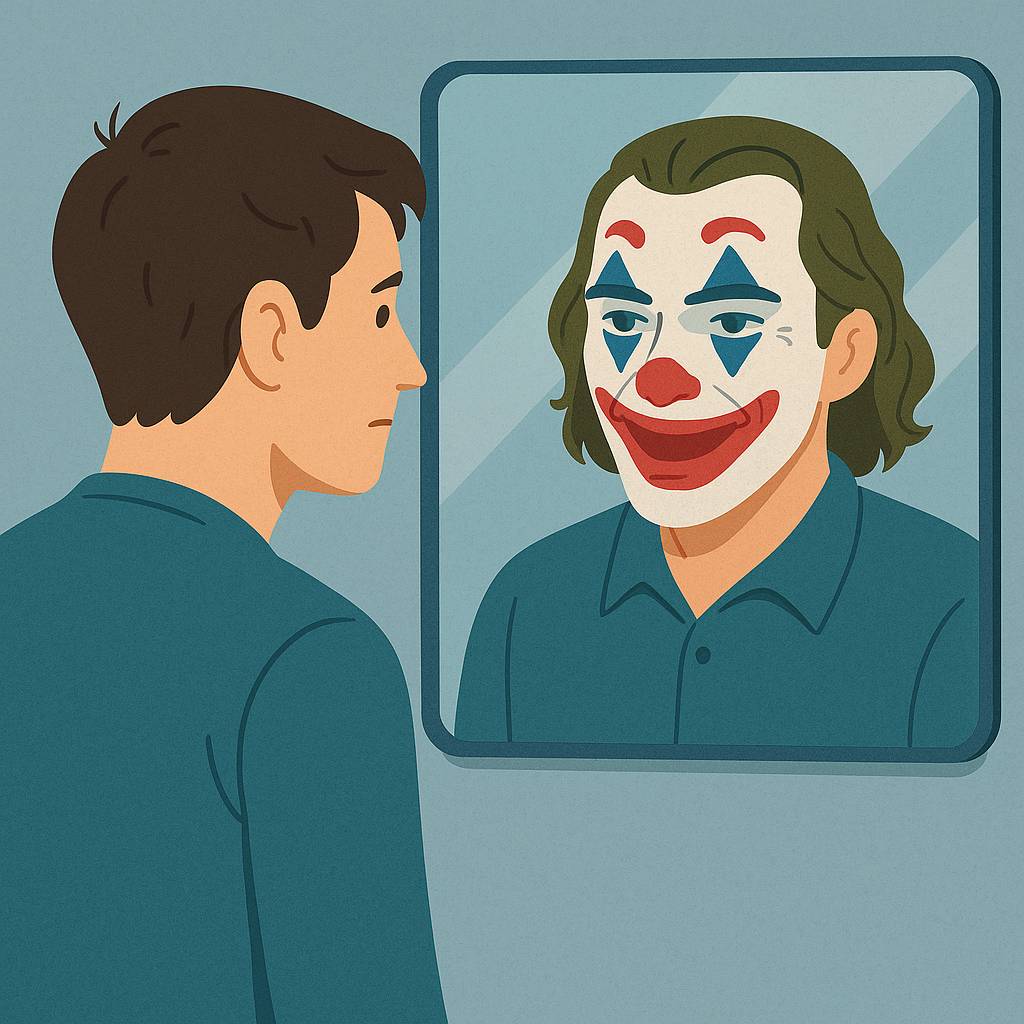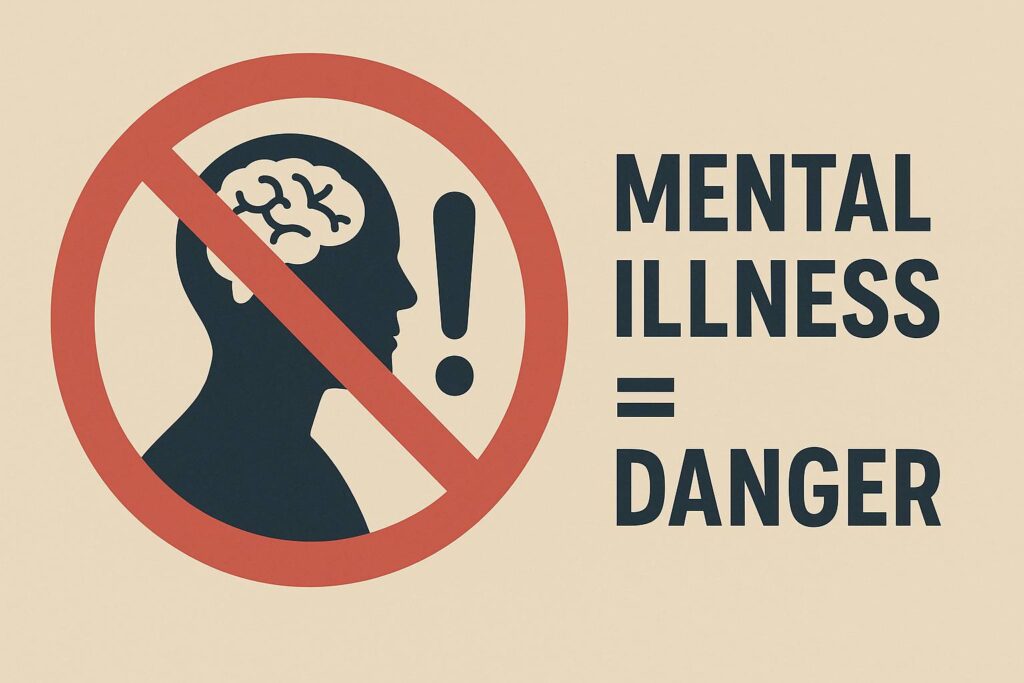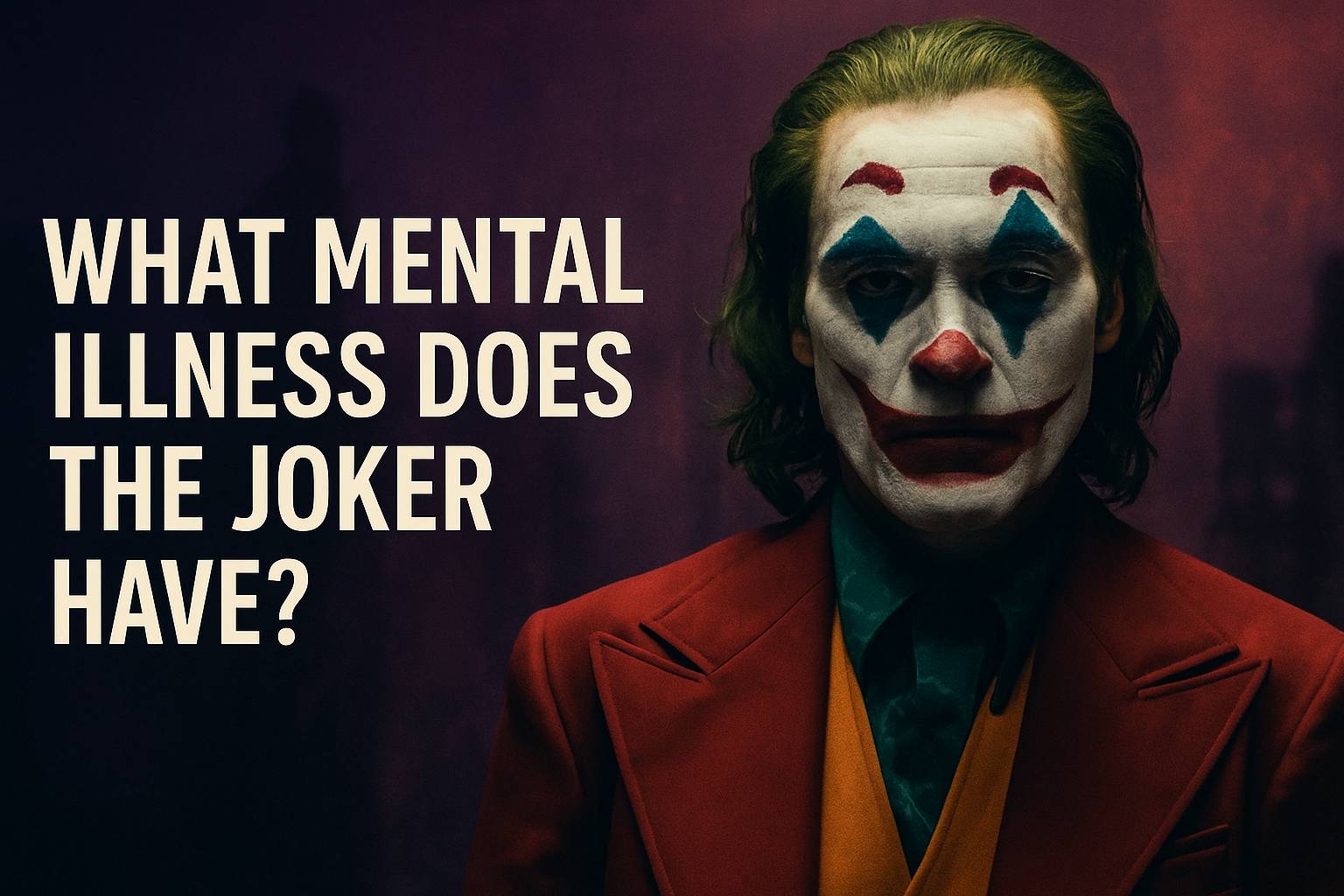What Mental Illness Does the Joker Have? (Movie Psychology Explained)

Why the Joker’s Psychology Fascinates Viewers
Before we look at possible diagnoses, it helps to ask why people are so drawn to the Joker’s psychology. For many, he is not just a comic book villain but a complex figure whose actions raise deeper questions about trauma, society, and mental health.
A character shaped by trauma and chaos
The Joker is often portrayed as someone deeply affected by trauma and neglect. In films such as Joker (2019), we see him facing poverty, social isolation, bullying, and a lack of medical support. These hardships create a chaotic environment that fuels his transformation into a violent figure.

In psychiatry, trauma is recognized as a major risk factor for developing mental health problems. While the film exaggerates these events for dramatic impact, the link between early adversity and later psychological struggles is well documented. In my own practice, I often meet patients who carry the scars of difficult life experiences — though, of course, their reality is very different from the extreme violence shown on screen.
Why audiences link him to real psychiatric conditions
Viewers naturally try to understand disturbing behavior by connecting it with known psychiatric disorders. The Joker’s instability, unpredictable actions, and altered perception of reality lead many to speculate about psychosis, personality disorders, or even neurological issues such as pseudobulbar affect.
In the clinic, I have noticed that when patients or families mention characters like the Joker, they are usually trying to make sense of their own concerns. Pop culture offers a familiar reference point, making it easier to talk about psychiatric symptoms that might otherwise feel frightening or abstract.
What Mental Illness Does the Joker Have?
The question “What mental illness does the Joker have?” often comes from viewers who notice his disturbing behavior and wonder how it relates to real psychiatric conditions. While the character is fictional, his traits resemble symptoms seen in different mental health disorders, which is why audiences — and even some experts — continue to debate this topic.
Key behavioral traits shown in the films
Across different portrayals, the Joker displays a range of troubling behaviors. In Joker (2019), Arthur Fleck struggles with uncontrollable laughter, social withdrawal, and difficulty distinguishing fantasy from reality. In The Dark Knight, the character shows impulsivity, a lack of empathy, and a calculated enjoyment of chaos.

From a clinical perspective, these traits do not point to a single diagnosis. Instead, they resemble features seen in several different psychiatric conditions. For example, the uncontrollable laughter has been linked by some experts to a neurological issue called pseudobulbar affect. His violent outbursts and disregard for others suggest traits of antisocial personality disorder. At the same time, his paranoia and disorganized thinking resemble symptoms of psychosis.
It is important to emphasize that filmmakers combine these traits to create a compelling villain rather than to reflect a real patient. No single mental health disorder fully explains the Joker’s behavior, and this is one reason why experts are cautious about “diagnosing” fictional characters.
Differences between comic book and movie versions
The Joker’s portrayal changes dramatically depending on the source. In the comic books, he is often shown as a clever trickster with exaggerated cruelty, but his backstory is left vague. This ambiguity allows each reader to project their own interpretation of his motives.
In the movies, however, the character is given more psychological depth. The Dark Knight presents him as a mastermind of chaos, while Joker (2019) portrays Arthur Fleck as a struggling man with a documented history of trauma, poverty, and possible neurological illness. These differences make it clear that the “Joker” is not one consistent person but a collection of artistic choices designed to create tension and provoke thought.
Why no single diagnosis fits perfectly
From a medical perspective, the Joker cannot be explained by one diagnosis alone. He shows traits linked to antisocial personality disorder, psychotic episodes, and even neurological conditions like pseudobulbar affect. Yet none of these disorders, by themselves, account for his complete range of behaviors.
In my clinical experience, real patients rarely present with such a neat combination of symptoms. Films exaggerate and blend traits to heighten drama, which makes the character fascinating on screen but unrealistic as a psychiatric case study. For this reason, psychiatrists avoid labeling him with a single disorder and instead use him as an example of how mental illness is portrayed in popular culture.
Possible Psychiatric Conditions Linked to the Character
Although the Joker is fictional, many of his traits resemble symptoms seen in different psychiatric conditions. Viewers often compare his behavior to real disorders, and some patterns do align with established diagnostic categories — though never completely.
Antisocial personality disorder and lack of empathy
One of the most consistent traits across portrayals is the Joker’s disregard for the rights and feelings of others. He commits violence without remorse, manipulates people for personal gain, and shows no genuine empathy. These behaviors resemble antisocial personality disorder, a condition where individuals often ignore social rules and exploit others.
In clinical practice, antisocial traits are recognized when patterns of deceit, aggression, and lack of remorse persist over time. While the Joker represents an extreme version for dramatic effect, these features echo real psychiatric descriptions.
Narcissistic traits and the need for attention
The Joker also demonstrates an intense craving for recognition. In several films, he seeks the spotlight, using theatrical crimes to ensure he remains the center of attention. His exaggerated self-image and demand for acknowledgment resemble narcissistic traits.
In psychiatry, narcissistic personality disorder is defined by an inflated sense of self-importance, a need for admiration, and difficulty handling criticism. While the Joker’s actions are far more violent than those of typical patients, the desire to be seen and remembered aligns with the narcissistic profile.
Psychotic episodes: hallucinations and delusions
In Joker (2019), Arthur Fleck experiences episodes where he blurs the line between reality and imagination. One striking example is his imagined relationship with a neighbor, which later turns out to be a delusion. These scenes illustrate features of psychosis, a state where a person may lose touch with reality through hallucinations or false beliefs.

In clinical medicine, psychosis is associated with conditions such as schizophrenia or severe mood disorders. While the Joker’s portrayal dramatizes these experiences for effect, it mirrors symptoms that real patients describe: hearing voices, seeing things that aren’t there, or believing events that have no basis in reality.
Pseudobulbar affect (uncontrollable laughter) theory
Another memorable trait in Joker (2019) is Arthur’s uncontrollable laughter at inappropriate times. This has led some experts to suggest he may have pseudobulbar affect, a neurological condition where sudden, involuntary outbursts of laughing or crying occur.
In real patients, pseudobulbar affect is not a mental illness but a neurological disorder often linked to brain injury, multiple sclerosis, or other conditions affecting the nervous system. In the film, this symptom is used symbolically to highlight Arthur’s alienation from society. It reflects how physical symptoms can carry emotional weight, but it should not be mistaken for a psychiatric diagnosis on its own.
Expert Opinions on the Character’s Psychology
The Joker has attracted attention not only from audiences but also from mental health professionals. Psychiatrists and psychologists have often been asked whether his traits match any real diagnosis, and their insights highlight both the value and the limits of analyzing a fictional villain.
What psychiatrists say about the portrayal
Many psychiatrists agree that the Joker is not a textbook case of any one disorder. Instead, they describe him as a character built from a mixture of symptoms — antisocial traits, psychosis, trauma responses — chosen for dramatic storytelling.
Some mental health experts use him as an educational example. In lectures and articles, the Joker is sometimes presented as a way to illustrate warning signs such as delusional thinking or impulsive violence. However, most professionals caution that treating him as a “real patient” risks misunderstanding what psychiatric disorders look like in everyday life.
In my own experience as a physician, I find that fictional characters like the Joker can spark meaningful conversations. Patients may bring him up during appointments, and this opens the door to discussing their own symptoms in a less intimidating way.
Expert Opinions on the Character’s Psychology
Mental health professionals often analyze the Joker to explain why he fascinates audiences and how his traits compare to real disorders. Their views show both the educational value of the character and the limits of treating him like a real patient.
What psychiatrists say about the portrayal
Psychiatrists point out that the Joker does not fit one specific diagnosis. Instead, filmmakers combine traits — antisocial behavior, psychotic episodes, and responses to trauma — to create a compelling villain.
Clinicians sometimes use the character as a teaching tool. In lectures, they highlight his delusional thinking, emotional instability, or impulsive violence to help students recognize warning signs. At the same time, they warn against assuming that fictional characters reflect real patients.
In my practice, patients occasionally bring up the Joker when describing their own experiences. This reference helps me guide the conversation toward real psychiatric conditions and available treatments. Pop culture becomes a bridge, making it easier to discuss mental health without fear or stigma.
Why professionals avoid “diagnosing” fictional people
Psychiatrists avoid giving official diagnoses to fictional characters because movies exaggerate symptoms for drama. Filmmakers design the Joker to shock audiences, not to meet clinical criteria. If doctors treated him as a real patient, it could spread misconceptions about what disorders actually look like in daily life.
Instead, professionals emphasize the difference between storytelling and psychiatry. They remind the public that while the Joker shows traits resembling real conditions, no single diagnosis fully explains his behavior. This distinction protects patients from stigma and keeps medical discussions accurate.
Using film characters as teaching examples in psychiatry
Educators often use film characters in classrooms to spark discussion. A figure like the Joker helps students visualize concepts such as delusions, impulsivity, or lack of empathy. Because many students already know the character, they engage more actively with the lesson.
In my teaching experience, using examples from pop culture reduces anxiety around psychiatric terms. When students see how a movie scene illustrates psychosis or personality traits, they understand the concepts faster. This method shows how culture and medicine can work together to improve awareness of mental health.
How Fictional Portrayals Differ from Real Patients
Movies shape how the public imagines mental illness, but they rarely show conditions as doctors see them in everyday practice. The Joker reflects a mixture of exaggerated traits that serve the story rather than an accurate clinical picture.
Movie exaggeration for dramatic effect
Filmmakers amplify symptoms to create tension. They show the Joker with extreme violence, sudden outbursts, and theatrical behavior because these traits capture attention on screen. In reality, most people with psychiatric disorders do not act in such dramatic ways.
Directors often combine multiple conditions into one character. By blending psychosis, antisocial behavior, and neurological symptoms, they design a villain who feels unpredictable and frightening. This exaggeration works for cinema but misrepresents real patients.
The danger of stigma when linking villains to disorders
When movies present villains as “mentally ill,” audiences may assume that psychiatric conditions equal violence. Psychiatrists warn that this link fuels stigma and discourages people from seeking treatment. In truth, most individuals with mental health problems are not dangerous and often suffer more from discrimination than from their symptoms.
In my practice, I have seen patients hesitate to ask for help because they fear being labeled as “unstable” or “dangerous.” Media portrayals like the Joker can reinforce those fears, which makes education and accurate information even more important.
What real people with psychiatric conditions actually experience
Real patients live with challenges that rarely appear in movies. They struggle with fatigue, anxiety, difficulty maintaining relationships, or finding steady employment. Their lives involve coping with symptoms day by day, not orchestrating chaos on a grand scale.
Treatment also looks very different from what films suggest. With therapy, medication, and community support, many patients manage their conditions successfully and lead fulfilling lives. Highlighting these real stories helps reduce stigma and shows that psychiatric care works.
How Fictional Portrayals Differ from Real Patients
Movies shape how the public imagines mental illness, but they rarely show conditions as doctors encounter them in daily practice. The Joker reflects a mixture of traits that writers exaggerate to serve the story, not to mirror a real clinical picture.
Movie exaggeration for dramatic effect
Filmmakers amplify symptoms to create tension. They show the Joker with extreme violence, sudden outbursts, and theatrical behavior because these traits grab attention. In real life, people with psychiatric disorders usually struggle quietly rather than acting in explosive ways.
Directors blend multiple conditions into one character. They combine psychosis, antisocial behavior, and neurological issues to design a villain who feels unpredictable and frightening. This storytelling technique dramatizes mental illness but misleads audiences about reality.
The danger of stigma when linking villains to disorders
When movies link villains to “mental illness,” viewers often conclude that psychiatric disorders equal violence. Psychiatrists warn that this stereotype fuels stigma and stops people from seeking treatment. In truth, most individuals with mental health problems pose no threat and often suffer more from prejudice than from their symptoms.

I often meet patients who hesitate to ask for help because they fear being judged. Media portrayals like the Joker reinforce those fears, which makes education and open discussion even more important.
What real people with psychiatric conditions actually experience
Patients in real life face challenges that films rarely show. They battle fatigue, anxiety, or difficulties maintaining work and relationships. Their struggles happen quietly, not through grand acts of chaos.
Treatment also looks very different from the screen. Doctors prescribe medication, therapists teach coping strategies, and families provide support. With consistent care, many patients regain stability and build fulfilling lives. Sharing these real stories reduces stigma and proves that treatment works.
Why This Discussion Matters
Conversations about the Joker’s psychology go beyond entertainment. They influence how people understand mental health, how society treats patients, and how stigma either grows or fades.
How movies shape public views on mental health
Movies strongly influence how audiences imagine psychiatric conditions. When filmmakers show a villain as “mentally ill,” viewers often connect mental illness with danger. This pattern can create fear and misunderstanding.
At the same time, cinema can highlight real struggles. Joker (2019), for example, portrays poverty, social isolation, and lack of medical care — issues that genuinely affect patients. When films show these realities, they help the public recognize mental health as a serious social concern.
The importance of separating fact from fiction
Psychiatrists stress the need to separate movie characters from actual patients. The Joker represents an artistic creation, not a clinical case study. If audiences confuse fiction with reality, they risk forming false ideas about what psychiatric conditions look like in daily life.
Doctors encourage people to enjoy films while remembering that real patients often suffer quietly and seek support, not chaos. Clear separation between fiction and fact helps reduce stigma and protect those who live with mental illness.
Using pop culture to raise awareness about mental health
Teachers, doctors, and advocates often use film characters to spark conversations. Pop culture provides a familiar entry point for difficult topics. When students or patients discuss the Joker, professionals can use that moment to explain symptoms, treatment, and hope for recovery.
In my own experience, referencing movies reduces fear. Patients feel more comfortable describing their struggles when they connect them to a character everyone knows. This approach turns entertainment into a tool for education and awareness.
Frequently Asked Questions
Did the Joker ever receive an official diagnosis in the films?
No. The films never give the Joker a formal psychiatric diagnosis. Writers and directors intentionally keep his condition vague to make the character more mysterious and unsettling.
Why does the Joker laugh uncontrollably?
In *Joker (2019)*, Arthur Fleck experiences sudden bursts of laughter linked by some experts to pseudobulbar affect, a neurological condition. In the story, it also serves as a symbol of his isolation and pain.
Could the Joker’s symptoms be treated in real life?
Yes. Traits such as psychosis or mood instability can often improve with medication and therapy. However, the Joker combines multiple exaggerated conditions, which makes his case unrealistic compared to real patients.
Is it harmful to link villains with mental illness?
Yes. Psychiatrists warn that linking villains to psychiatric conditions increases stigma and fear. In reality, most people with mental illness are not violent and deserve compassion and support.
Why do doctors use film characters like the Joker in teaching?
Teachers and clinicians use familiar movie characters to illustrate psychiatric concepts. A figure like the Joker makes it easier for students or patients to understand symptoms and talk about mental health without stigma.
Expert’s Closing Note
“As a physician, I often hear patients and students mention the Joker when they talk about mental health. Fictional characters like him spark curiosity, but they do not represent real patients. Movies exaggerate traits for drama, while real psychiatric conditions affect people in quieter but very serious ways. My advice is to enjoy the films, but remember that true understanding of mental illness comes from listening to patients and seeking medical knowledge, not from Hollywood scripts.”
— Dr. Emily Hart, MD
Board-Certified Physician in Internal Medicine













